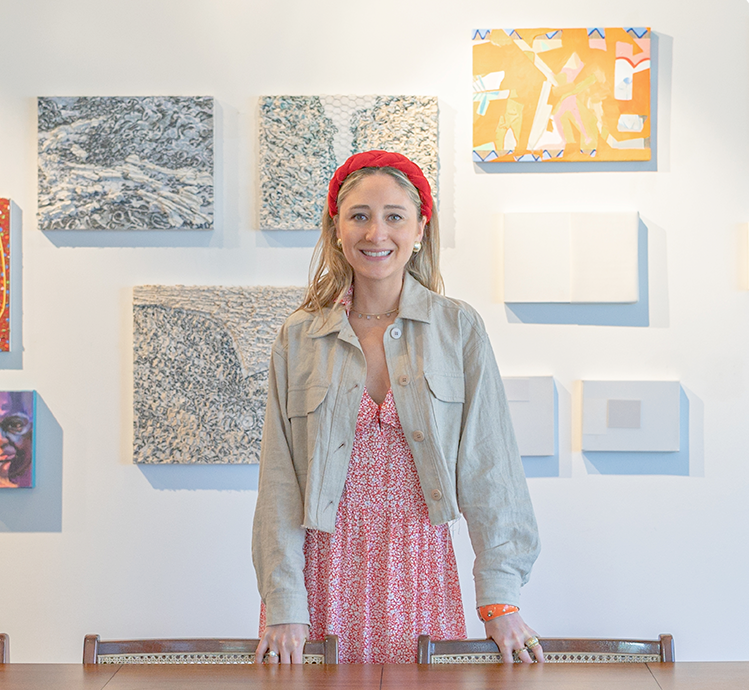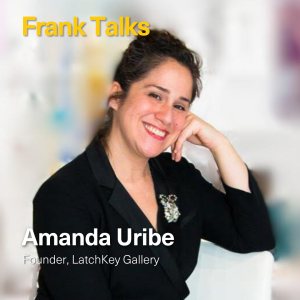Gabriela Schattan founded Gate, a New York-based portal for Brazilian Art, in 2021. She grew up in Brazil graduating with a degree in business from Fundação Getúlio Vargas in São Paulo in 2012. After graduation, she worked at Interbrand, an international branding consultancy in their São Paulo office, at Galeazzi & Partners, a Brazilian administrative management and general management consulting company and in sales and marketing at One Up, her family’s fashion business.
What was your first job in the Arts?
Gate is my first job in the arts. I graduated with a business degree from Fundação Getúlio Vargas São Paulo and worked in a branding consultancy, a business consultancy, and my family’s fashion business.
What was the most useful or important thing you learned at that job?
My biggest takeaway from the business world is the importance of people; the value of building relationships, connections, and teamwork. Everyone matters because in the end we all need each other.
Tell us a little more about yourself. When did you realize you wanted to pursue a career in this industry?
Art has always been my passion. I grew up in a home with a lot of Brazilian art. My husband and I moved to New York in January 2021 so he could work for his family’s business. A year before the move, I started thinking about building a cultural bridge between the United States and Brazil. For me, art was the way to do this. I became excited about having the opportunity to introduce young Brazilian artists to the United States. I strongly believe that sharing Brazilian art in NYC is necessary for the Brazilian art market and my research showed that Brazilians living in the United States were interested in seeing the work of young artists living and working in Brazil. New York is a global/cultural melting pot and Gate strives to strengthen New York’s Brazilian presence.
What do you do now?
In January I founded Gate – a portal for Brazilian art. Located in my apartment, Gate is not a gallery, not an arts platform; instead, we are interested in sharing stories and committed to supporting Brazil’s vibrant cultural scene. Through partnerships with leading Brazilian art galleries, we constantly showcase an updated selection of hand-picked artists and artworks. Choosing art is really about connecting with artists and their stories; selling art is not just about filling up walls, rather an opportunity to bring meaning and point of view to a home.
In New York my day-to-day involves introducing collectors, gallerists and art advisors to our program to independent art projects in Brazil. In Brazil I make many studio visits to see the artists who we work with and to find future artists to exhibit at Gate.
Where are you from?
I’m from São Paulo, Brazil.
What is the arts community like there?
The art community has grown a lot in Brazil. Young people are becoming increasingly more interested in connecting with art and buying art. Brazilians want to support local artists and want to share them with the world.
Has where you come from shaped what you do in the arts today?
My main goal is to help the art community in Brazil and to build an expanded audience for the work. The conversation around Brazilian art around the globe is very limited. Meanwhile, the country produces amazing art and artists that deserve more attention. Being surrounded by such art my whole life is what inspired me to create an art portal that connects New York with art from my home. Gate facilitates these conversations and exchanges that aren’t being had.
What is the best piece of advice you can give about working in the art world?
People have been buying, selling and viewing art for ages. I believe in a more connected way of working, where artists, galleries, art advisors, and museums can work together as a cohesive system. I believe in new models of sharing art, where more people can connect.
Art belongs to everyone. My piece of advice is, “make it accessible and available”. I created Gate to be a place where anyone can buy art from Brazil. It’s a place anyone can visit and learn from. My goal is to share Brazilian art and Brazilian artists with New York.
What is one of the greatest accomplishments in your career so far?
Being able to bring together art advisors, artists, galleries, and curators to launch Gate which is a different model than what already exists in Brazil.
What has been a challenge for you?
Handpicking what to show from Brazil and connecting to all the people who would like to engage IRL with Brazilian artists. There are many people searching and following Brazilian artists and Gate is a place to interact in person!
What is something you do every day at the office (or your current home office)?
Showing Gate to more and more people. There are no rules telling me who to show to, spreading art is about opening a space to tell stories.
What do you think defines a good employee? And what defines a good boss?
A good employee is someone who opens their heart to the business, which looks at the big picture and works with the boss’ vision. Nobody knows how to do everything, but everyone can learn.
A good boss is someone who knows how to delegate and lets people shine and learn. I believe letting people out of their comfort zone and challenging people to grow is the best a boss can do. Creative freedom goes a long way.
What do you think makes a person hirable?
Someone who is eager to learn and grow and fueled by passion.
What is your advice for making yourself stand out in your workplace? Any good tips for giving a great interview?
Courage, hard work, and patience. The world was not built in a day and in all cases of success, there is always a long story and tons of hard work.
Is there any advice you would like to give people entering the art world?
Don’t be intimidated and listen to your heart. Think about new models and opportunities. Do not take the standard as the only option, Work hard and show your opinions with results. Make friends and work in a network, everyone can help everyone and working together is much more fun.
What is the best exhibition you have seen in the last year?
Inhotim in Brazil. It’s considered the largest open-air museum in the world and it shows Brazilian Art alongside the greatest artists from around the world.
What artwork is in your home office?
I literally live in my gallery so I’m constantly surrounded by artwork! My dining room wall hosts a salon style hanging of our smaller pieces, my powder room features a large bright canvas, and my bedroom houses pieces by 8 different artists. It’s impossible to not be standing 5 feet away from an artwork at my home. We also change up the hangings quite often.
What is/was your greatest WFH challenge? Or a WFH luxury you don’t want to lose ever again?
My gallery doubles as my apartment so working from home means hosting various visitors each day. It’s like I’m living with art and collectors though coffees, lunch, dinners –– all hours of the day. I enjoy exhibiting at home because it shows potential clients how a piece will look in a home setting (it helps them envision the piece in their house) and also helps to create deeper connections and show Brazilian culture.
On the other hand, having people at home all the time, means having the apartment always ready and perfect for visitors. To accommodate this, I have meetings and do computer work outside my home.
How do you think art can play a fundamental role in the world’s recovery from Covid19?
Art is a form of expression. Creating, buying, and seeing art is a connection with emotions, opinions, politics, culture, beauty, etc..
In most challenging times, art is where we can converse and find comfort. Especially during this pandemic, when people are at home, bringing art inside is a way of bringing soul to the walls.
How do you think art should be shared and/or experienced moving forward?
Virtual viewings have made art accessible to many people who didn’t have access before. Someone across the globe can see what the MoMA is exhibiting. There are many benefits and I think digitizing exhibits should remain a thing. However, I also believe in partnership throughout the system so people worldwide can see art IRL and connect in a deeper way, independent of where the artist is from.
How has your current job adapted to the new virtual landscape? What do you think can be done better, if anything?
The art we exhibit is for sale on our website and all prices are visible. We don’t take down sold works because we like having a record of all the works we’ve had. Social media marketing is a big thing now and we are consistently posting on instagram and facebook to engage with followers and potential new followers. Instagram is how people discover and get to know brands and companies nowadays, so we make sure that our account reflects what we’re all about. Gate is always working to create new and exciting content to keep people engaged. Social Media’s “share” feature is a very useful tool for networking and getting your brand noticed by new people.
It can be argued that the art world has finally been forced to adopt and adapt technologies that have long been a part of other industries. Agree or Disagree?
I agree. The art world is changing for the better; the antiquated foundation it relied on is changing. The main added benefit of increasing online presence is the accessibility it offers. Some people can’t afford museum tickets or can’t make the commute to see high-art. For so long, fine art has been considered a luxury for the elite. Putting exhibits online and on social media makes art for the public again –– for everyone.
And finally, do you think the art world should be more transparent?
Yes, as in my answer to a previous question, the behind the scenes of the art world can seem very secretive and elitist. It’s the famous auction houses and rich museum board members that have the power in this world. Often what happens isn’t communicated or visible to the public. People are taking note of this and demanding accountability and change, especially towards museums.




